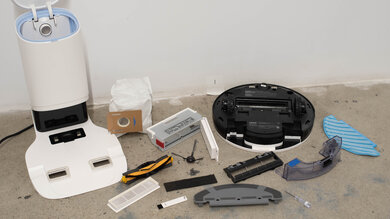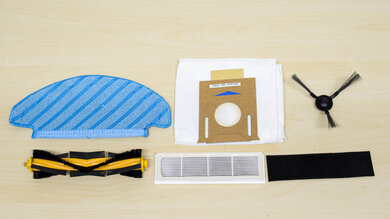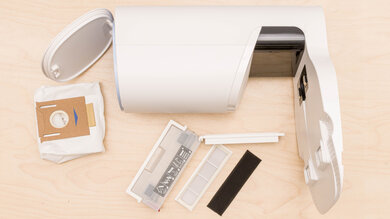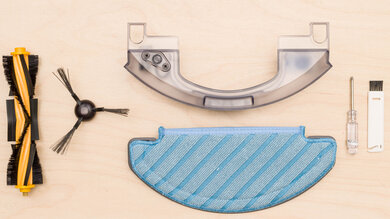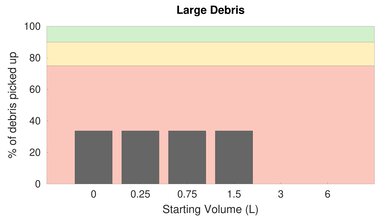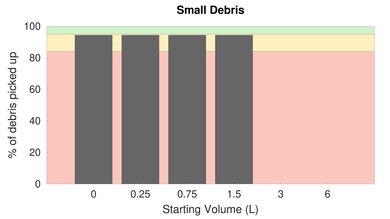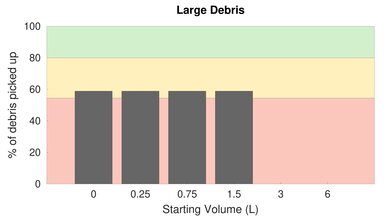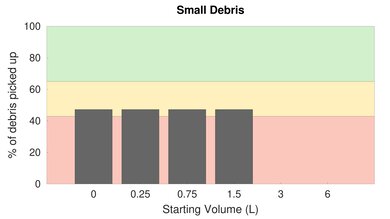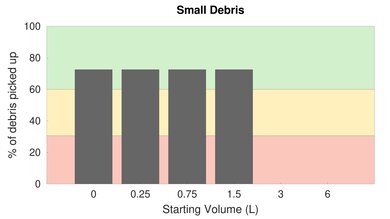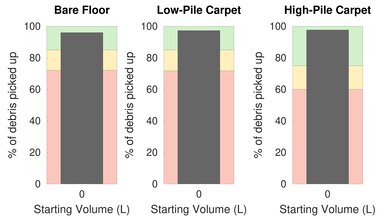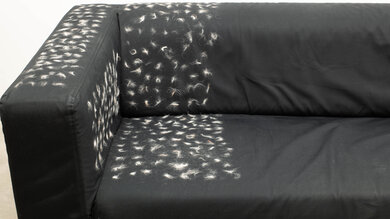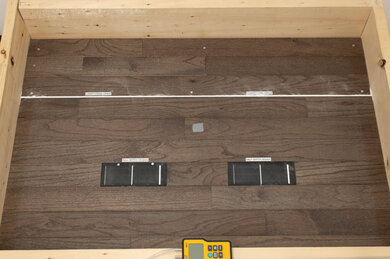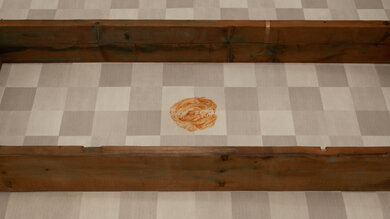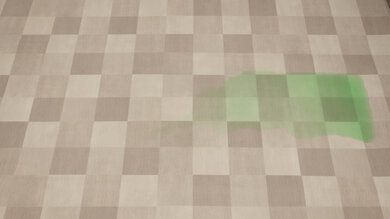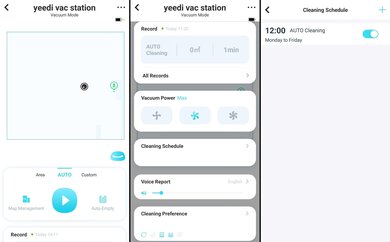The yeedi vac station is a mid-range robot vacuum with a self-emptying feature, which is rare for a vacuum at this price point and helps to reduce hands-on maintenance requirements. It feels well-built, has a remarkably long battery life, and does an excellent job of maneuvering itself. However, while it performs well on high-pile carpet, it struggles somewhat with bulky debris and has a hard time dealing with messes on low-pile carpets. It has a mopping feature, but it'll probably require a couple of passes to fully clean up dried-on stains.
Our Verdict
The yeedi vac station is decent for cleaning bare floors. It easily clears pet hair and small debris but has a hard time dealing with bulkier material. It offers a wide range of automation features, including its self-emptying function. It also does an excellent job of maneuvering itself. On the downside, recurring costs are high, and quite a few parts need regular cleaning.
-
Automatically empties dirt compartment into large external dirtbag.
-
Amazing maneuverability.
-
Great build quality.
-
High recurring costs.
-
Many parts need regular cleaning.
-
Inefficient mopping attachment.
The yeedi vac station is satisfactory for cleaning low-pile carpet. It sucks up pet hair without issue but can struggle in clearing fine debris like baking soda and larger material like sand. It also has many parts that need regular replacing, leading to high recurring costs. It also has fairly demanding maintenance requirements, though its self-emptying base station does help alleviate some of that. Still, it feels very well-built, has a long battery life, and has a wide selection of automation features.
-
Automatically empties dirt compartment into large external dirtbag.
-
Amazing maneuverability.
-
Great build quality.
-
High recurring costs.
-
Many parts need regular cleaning.
-
Can get caught on rug tassels.
The yeedi vac station is a decent option for cleaning high-pile carpet. It sucks up pet hair and large debris without an issue, but it may need to make an extra pass to clear fine debris like baking soda. It can easily maneuver on this surface type and automatically increases its suction power once it detects it's on carpet. Battery performance is superb, and the vacuum itself feels very well-built.
-
Automatically empties dirt compartment into large external dirtbag.
-
Amazing maneuverability.
-
Great build quality.
-
High recurring costs.
-
Many parts need regular cleaning.
-
Can get caught on rug tassels.
The yeedi vac station is excellent for cleaning up pet hair on floors, though you'll probably need another vacuum to gather it everywhere else. It easily clears pet hair on different surface types and has a removable brushroll, allowing you to clear any tangled hair without too much effort. It's also very quiet, even at higher power levels, which is great if your pet is sensitive to loud noises. However, while it feels well-built, many parts should be regularly cleaned or even replaced, so recurring costs are high. It also does a terrible job of sealing in fine allergens like pet dander. While it has a mopping feature to help deal with stains, it might take a few passes to fully scrub away tracked-in mud and dirt.
-
Clears pet hair on a wide variety of surface types.
-
Removable brushroll.
-
Great build quality.
-
High recurring costs.
-
Many parts need regular cleaning.
-
Terrible air filtration performance.
-
Inefficient mopping attachment.
The yeedi vac station is a robot vacuum and isn't designed to clean stairs.
The yeedi vac station is a robot vacuum and isn't meant to clean the inside of your car.
The yeedi vac station is a robot vacuum and isn't suitable for use in workshops.
- 7.1 Bare Floor
- 7.4 Low-Pile Carpet
- 7.4 High-Pile Carpet
- 5.7 Pets
- 5.8 Stairs
- 4.8 Cars
- 4.5 Workshop
Changelog
- Updated Dec 14, 2023: Converted to Test Bench 0.7.
- Updated Sep 15, 2022: Updated 'Bare Floor Performance (Hardwood, Laminate, Tiles)' field to include a link to the newly-reviewed Shark AI Ultra Robot AV2501S as an alternative with superior debris pickup performance on hard floors.
- Updated Aug 03, 2022: We've updated this review to Test Bench 0.6, which involves reevaluating the vacuum's 'Dirt Compartment' score along a new curve and changing the scoring criteria for the 'Workshop' usage section.
- Updated Aug 03, 2022: Converted to Test Bench 0.6.
- Updated Jul 08, 2022: We've updated this review to Test Bench 0.5, which includes a broad range of new testing procedures to measure stain and water-clearing performance, suction power, crevice-cleaning performance, noise levels, and air filtration performance. We've also updated our debris and pet hair-pickup performance tests as well as our method of scoring user maintenance requirements and recurring cost.
Differences Between Sizes And Variants
The yeedi vac station is only available in one color variant: 'White', and you can see its label here.
Let us know in the discussions if you come across another variant of this vacuum, and we'll update our review.
Compared To Other Robot Vacuums
The yeedi vac station is a mid-range robot vacuum with a self-emptying capability, similar to the Shark EZ Robot Self-Empty or the iRobot Roomba i7. It offers excellent performance on bare floors and clears an impressive amount of debris on high-pile carpet. It also feels well-built and offers a wide range of automation features. That said, like many robot vacuums, it incurs many recurring costs and has quite a few components that need regular replacing.
If you're looking for alternatives, take a look at our list of recommendations for the best robot vacuums, the best robotic vacuums for hardwood floors, and the best robot vacuums for pet hair.
The yeedi vac station is better than the Shark EZ Robot Self-Empty. The yeedi feels better built, is less demanding in terms of maintenance, delivers a wider range of automation features, including virtual boundary markers, and is more maneuverable. Meanwhile, the Shark clears debris more effectively on low-pile carpets and takes less time to recharge, though its maximum battery life is slightly shorter. The yeedi's self-emptying base station also uses disposable dirtbags that have a much larger capacity.
The yeedi vac station is better than the yeedi k650, but the K650 is still a great option if you're on a budget. The vac station has a wider range of automation features, most notably its self-emptying function, which also gives it a larger effective debris capacity than the K650 and reduces hands-on maintenance requirements. The vac station is also better-built, has less demanding maintenance requirements, maneuvers itself far more effectively, and delivers better performance on carpeted floors. Meanwhile, the K650 has a longer maximum battery life while taking notably less time to recharge. It also delivers superior performance on bare floors and incurs lower recurring costs.
The yeedi vac station is better than the eufy RoboVac G30. The yeedi is better built, has less demanding maintenance requirements, maneuvers itself more effectively, performs better on carpeted floors, and lasts longer on a single charge, though the eufy charges faster. The yeedi also has a broader range of automation features, most notably its self-emptying feature. Meanwhile, the eufy is a little easier to store and incurs lower recurring costs.
The iRobot Roomba S9 and yeedi vac station each have their own advantages, so one may suit you better than the other, depending on your needs. The iRobot is better built, incurs lower recurring costs, is equipped with an allergen-trapping HEPA filter, doesn't struggle with bulky debris, and performs considerably better on low-pile carpet. It also charges considerably faster than the yeedi. Meanwhile, the yeedi's self-emptying feature reduces hands-on maintenance requirements and gives it a much larger effective debris capacity. The yeedi also delivers better performance on high-pile carpet. It's also equipped with a mopping attachment for clearing messes on bare floors but dealing with dried-on debris takes quite a while.
The yeedi vac station is slightly better than the iRobot Roomba i7. The yeedi incurs less demanding maintenance requirements, incurs lower recurring costs, and delivers superior performance on high-pile carpet. It also has a longer battery life in its most energy-efficient configuration, though the iRobot charges a lot faster. The iRobot also clears more debris from low-pile carpet, is equipped with an allergen-trapping HEPA filter, and has a marginally greater debris capacity.
The yeedi vac station is better than the iRobot Roomba i3 for most uses. The yeedi has fewer parts that require regular cleaning, incurs lower recurring costs, maneuvers itself more effectively, and clears notably more debris on carpeted floors. It also has a much longer maximum battery life, though the iRobot does take much less time to recharge. The iRobot also has a slightly larger external dirt compartment, has a HEPA filter to trap allergens as it cleans, and is a little easier to store.
The yeedi vac station is better than the iRobot Roomba 675. The yeedi delivers much better performance on carpeted floors, maneuvers itself far more effectively, and has a wider assortment of automation features, including its self-emptying function and support for virtual boundary markers. It also has a longer battery life than the iRobot, though the latter does charge a lot faster. The iRobot also incurs lower recurring costs and struggles slightly less with bulkier debris.
The yeedi vac station is better than the iRobot Roomba j7, though the iRobot might suit you better depending on your exact needs. The yeedi has fewer parts requiring regular maintenance, incurs slightly lower recurring costs, and performs better on carpeted floors. It also comes with a mopping attachment to clear sticky messes on bare floors. However, the iRobot charges considerably faster, has an easier time dealing with bulky debris, and has a unique hazard-detection feature for identifying and avoiding hazards like pet waste.
The yeedi vac station is better than the Shark AI Ultra Robot for most uses. The yeedi feels better built, has fewer parts needing regular cleaning, does a better job maneuvering itself, has an easier-to-use companion app, performs better on carpeted floors, and comes with a mopping attachment for dried-on stains, though the latter isn't especially effective. The yeedi's external dirtbag also has a larger overall capacity than the Shark's bagless external dirt compartment. However, the Shark does a better job of sealing in fine allergens and clears more debris on bare surfaces.
Test Results
The yeedi vac station feels well-built. The vacuum body and base station are both made of primarily matte-finish hard plastic that looks premium. It feels sturdy for the most part, though the vacuum's internal dustbin does feel as though it could break if you drop it.
Setup is fairly simple, requiring only that you attach the base to the dust container with the provided screws and screwdriver.
The yeedi vac station has many parts that require regular maintenance.
- Dustbin: The dustbin is found under the top cover of the vacuum and has a handle for easy removal. A release button on the dustbin opens the door and drops any accumulated debris. The vacuum automatically dumps accumulated debris into the external dirt bin on the charging dock, but you can empty it yourself if you feel that it's necessary.
- Internal filters: The high-efficiency and sponge filters are behind the internal dustbin door, and you can simply pull them out. They should be rinsed with water once a week and left to dry for at least 24 hours before you can reuse them.
- Base station dust bag: You can access the dirtbag by pressing the release button on the top of the base station and then pulling it out. The bag features a locking mechanism that prevents debris from spilling out when you remove it from its housing. You should dispose of it once it gets full.
- Base station: You should clear the base station's charging pins and sensors of any dust or debris regularly. If necessary, you should also clean the blower cover, found under the dirtbag, and the dust evacuation tube cover, which is under the base station but first needs unscrewing from its housing.
- Brushroll: To access the brushroll, you must first remove the brush guard from under the vacuum. You can pull it from its housing and remove any tangled hair or stuck-on debris. You should do this once a week.
- Side brushes: You should clear the side brushes of any stuck-on debris every two weeks.
- Front wheel: You can't remove the front wheel from its housing, but you should still try to clear any accumulated dust, dirt, or hair from this component when necessary.
- Sensors and charging pads: You should dust the sensors and charging pads whenever you notice a buildup of debris.
We don't currently evaluate mopping performance, so the associated user maintenance for mopping attachments doesn't factor into this section's score. That said, the maintenance requirements for the mopping attachments are as follows.
- Water reservoir: You can pull out the water reservoir by pressing the release button on the back of the vacuum. You should empty it after the vacuum finishes mopping. Make sure to remove the rubber lid cover before cleaning it out with water, which you should do following every use.
- Mopping pad plate: You should clean the mopping pad plate after the end of each mopping session.
- Mopping pad: The mopping pad is washable, and you should clean it after the end of each mopping session.
The yeedi vac station incurs moderately high recurring costs.
- High-efficiency filter: You should replace the high-efficiency filter every three to six months or after 120 hours of cleaning time.
- Base station dust bag: The dustbag should hold 30 days worth of debris. You can buy them in packs of three from the manufacturer's website.
- Brushroll: You should replace the brushroll every six to 12 months or after 300 hours of cleaning time, depending on your usage.
- Side brushes: You should replace the side brushes every three to six months or after 150 hours of cleaning time.
yeedi sells these components individually as well as replenishment kits, which include 2x side brushes, 1x brushroll, and 3x filters.
The yeedi vac station is impressively easy to store. Its base station is roughly the same size as the i-series self-emptying docking station that comes with the i7+ variant of the iRobot Roomba i7, and the vacuum itself is small enough to fit under tables or closets.
The combined capacity of the yeedi vac station's external dirtbag and internal dustbin is impressive. The manufacturer advertises the dirtbag to hold 30 days' worth of accumulated debris, but you can't easily check how full it is from the outside.
- yeedi vac station vacuum
- Robot vacuum body
- Internal dust bin
- High-efficiency and sponge filters
- 1x Side brush
- Brushroll
- Brushroll guard
- Water reservoir
- Mopping pad plate
- Washable mopping pad (on mopping pad plate)
- Cleaning tool
- Instructional Manual
- Base station
- Base plate
- Base station dust bin (with 3x mounting screws)
- 2x dirtbags
- Clear plastic ramp extension
- Screwdriver
- Power cord
The yeedi vac station's range is limited only by the room left in its dirt compartment and its remaining battery life. However, it can't climb or descend staircases.
The yeedi vac station is very portable. While it lacks a carrying handle, it still doesn't weigh that much, meaning you can pick it up without much effort.
The yeedi vac station has fantastic battery performance. On its 'Standard' suction power setting, it supplies almost 180 minutes of runtime on a single charge, which should be more than enough for cleaning most rooms. Using it in its 'Max+' suction power mode, its battery life drops to a little over 80 minutes, though this should be sufficient for most spaces. It also takes considerably longer to recharge than alternatives like the iRobot Roomba j7. You can keep tabs on the vacuum's remaining charge by looking at the 'Auto' mode button on top of the vacuum, which turns from white to red when its battery is running low.
The yeedi vac station has a couple of quality-of-life features. It has three suction power modes: 'Standard', 'Max', and 'Max+'. The vacuum automatically switches to its highest power setting once it detects it's on carpet. It can also stop a mopping run when it detects that it's on carpets.
The yeedi vac station comes with a side brush to direct debris onto the path of its primary brushroll. There's also a cleaning tool to clear tangled hair or stuck-on debris. This vacuum also has a mopping attachment to clear messes on bare floors.
The yeedi vac station delivers poor performance on bare floors. It clears away small debris like rice but struggles somewhat with sucking up bulky material like cereal. You might want to take a look at the Shark AI Ultra Robot if you're looking for a self-emptying robot vacuum that performs better on this floor type.
Note: All testing was completed when the dirt compartment was empty, with the data for the 0.25L, 0.75L, and 1.25L tests being copied from the 0L test. Since this vacuum automatically empties its internal dirt compartment when docked after completing its job, it doesn't lose suction performance.
The yeedi vac station's performance on low-pile carpet is passable. It clears pet hair without difficulty, but it may need to make an extra pass to clear fine debris like baking soda or larger material like sand, which can get stuck in its suction inlet, as seen here You can rectify this issue by running the vacuum twice.
Note: All testing was completed when the dirt compartment was empty, with the data for the 0.25L, 0.75L, and 1.25L tests being copied from the 0L test. Since this vacuum automatically empties its internal dirt compartment when docked after completing its job, it doesn't lose suction performance.
The yeedi vac station offers great performance on high-pile carpet. It clears pet hair without an issue and sucks up a good amount of larger debris like sand. That said, it struggles somewhat with fine debris like baking soda.
Note: All testing was completed when the dirt compartment was empty, with the data for the 0.25L, 0.75L, and 1.25L tests being copied from the 0L test. Since this vacuum automatically empties its internal dirt compartment when docked after completing its job, it doesn't lose suction performance.
The Roborock S7 MaxV real-world suction is pretty strong compared to most other robot vacuums in its price bracket. Still, like most other robot vacuums, the suction inlet isn't low enough to generate a tight seal on bare surfaces, resulting in low real-world suction power measurements.
The yeedi vac station is exceptionally quiet. It makes much less noise than even high-end models like the iRobot Roomba S9. You'll hear nearby conversations even with the vacuum running in its high-power 'Max' mode.
The yeedi vac station has amazing maneuverability. It's small enough to easily navigate under tables and couches. Its automatic suction power adjustment feature is effective in adjusting suction depending on the surface that it's on. It also doesn't get stuck on obstructions like electrical cords or rugs, though it may drag them around. Unfortunately, it can get caught on rug tassels, and the manufacturer recommends tucking them under rugs to reduce the risk of the vacuum getting stuck on them.
The yeedi vac station has middling air filtration performance. It isn't rated as allergen-sealed, meaning fine particles can escape from its exhaust. It makes it a poor option if you suffer from allergies.
The yeedi vac station has poor crack-cleaning performance. It's reasonably effective in capturing fine particles in shallow and medium-depth crevices. However, as soon as it deems the cleaning job complete and starts seeking its charging dock, suction is shut off, causing debris to fall from its suction inlet.
The yeedi vac station has a somewhat inefficient mopping feature. Unlike the Roborock S7, this vacuum doesn't vibrate the mop pad to generate a scrubbing action, and simply drags along the mop pad as it moves around, resulting in poor single-pass cleaning performance. The manufacturer recommends pre-soaking the pads for dealing with dried-on stains. While this does improve peformance, doing so leaves a noticeable amount of residue behind.
Note: The results indicate how the vacuum performed using our standard testing methodology, which are obtained by having the vacuum run a single three-minute mopping cycle. It performs significantly better if you let it run for several cycles. You can see the vacuum run two cycles here, and the outcome of that test here. If you run it for five cycles, it should thoroughly clear away most dried-on stains. However, this does cause the mopping pad to become quite dirty.
The yeedi vac station offers a remarkable range of automation features. The vacuum's smart-pathing navigation system creates a permanent map of its coverage area, which you can access in its companion app. Its self-emptying function allows it to transfer debris from its internal dirt compartment into an external dustbin on its dock, reducing hands-on maintenance requirements. It also has an 'AUTO' mode button, which you can use to have the vacuum clean the immediate floor plan.
The yeedi vac station has a great companion app. You can access its coverage map to label certain areas or set up virtual boundary lines, unlike the Xiaomi Mi Robot Vacuum. You can also schedule cleaning sessions for individual rooms or even small, specific areas. You can also use the app to check the estimated service life of various components, change its suction power mode, or check its remaining battery charge level. However, you can't use the app to make directional changes, which would be helpful if the vacuum were to get stuck.



